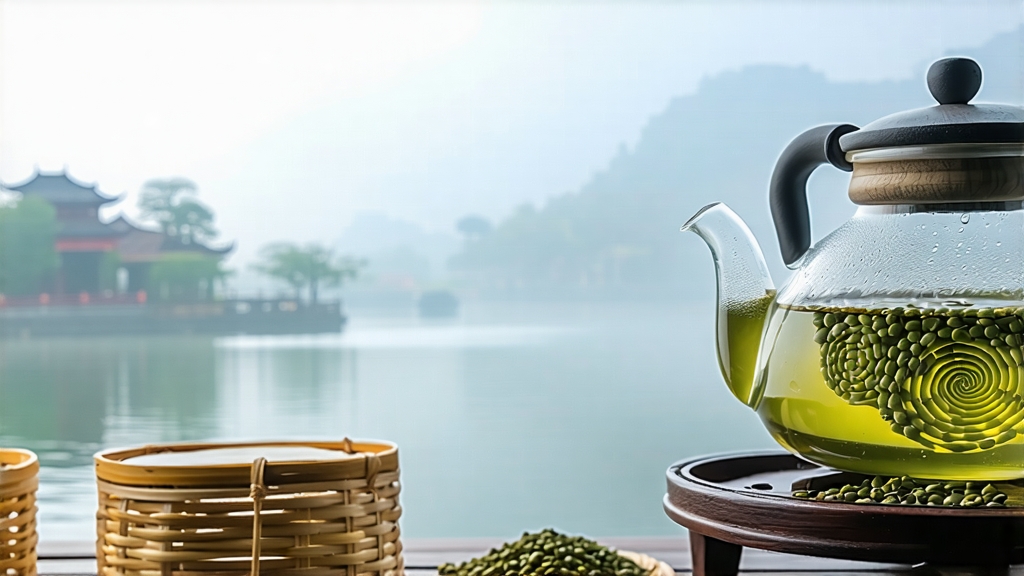
Among the more than one thousand named green teas that China has gifted to the world, few carry the romance, rarity, and sensory drama of Biluochun. Literally “Green Snail Spring,” the name alone evokes the tight spiral that each leaf forms after being coaxed by heat and the nimble fingers of farmers on the mist-laden hillsides of Dongting Mountain in Jiangsu Province. To the Chinese palate it is one of the ten famous teas; to the international explorer it is a miniature green sculpture that releases an improbable bouquet of orchid, ripe peach and steamed edamame in a single sip. This essay invites the global reader to travel from Tang-dynasty poetry to twenty-first-century sustainability labs, tracing how a once-secret imperial tribute survives as a living art.
-
Historical whispers from the lake
Taihu (Lake Tai) cradles Dongting Mountain, actually two islands—East and West—anchored in a body of water so revered that poets called it “the mirror of heaven.” Tea gardens here benefit from a micro-climate in which cool lake vapor meets subtropical sun, creating a natural shade cloth that slows leaf growth and concentrates amino acids. The first written record appears in the Tang Dynasty (618-907) “Tea Canon,” but the name Biluochun was only fixed during the late Ming when the Kangxi Emperor tasted it on his southern inspection tour. Enchanted by the spirals that “resembled the whorls of a jade snail,” he changed the original folk name “Xia Sha Ren Xiang” (literally “scary fragrance”) to the more elegant one we use today. From 1699 onward the entire crop was delivered to the Forbidden City; commoners risked punishment for picking even a handful. When the last dynasty fell in 1911, the gardens reverted to monks and smallholders, yet the mystique endured. Today only about 110 hectares of core-zone terroir on the two islands are recognized as true “Dongting Biluochun,” yielding roughly 60 tons a year—less than one gram for every inhabitant of China. -
Cultivar and picking code
The plant itself is a landrace of Camellia sinensis var. sinensis locally called “Xiao Ye” (small leaf). Its elliptic buds are unusually hairy; the downy trichomes act like miniature dew nets, capturing morning mist and contributing to the tea’s silvery sheen after firing. Orthodox picking follows the “early, tender, clean” rule: only the single standing bud and the immediately unfolding first leaf, plucked before the Qingming festival (around April 5). One kilo of finished tea demands between 60 000 and 72 000 such sets, all gathered before ten o’clock so that the leaf remains cool and turgid. Pickers wear breathable bamboo hats rather than gloves, because any friction bruises the cell walls and triggers premature oxidation that would flatten the signature floral note. -
The six breaths of craft
Unlike pan-fired teas such as Longjing, Biluochun is entirely wok-shaped while the leaf is still wet from the morning dew. Masters divide the kill-green operation into six “breaths,” each lasting 30–45 seconds. Breath 1: high heat (280 °C) to destroy enzymes; the artisan rolls the leaf against the scorching iron with the bare palm, trusting years of callus. Breath 2: temperature drops to 200 °C; fingers tuck the leaf into a loose ball, beginning the spiral. Breath 3: 150 °C, the ball is rotated clockwise 36 times—never more, never less—to fix the amino acids. Breath 4: 100 °C, the spiral tightens under gentle pressure, like a miniature strudel. Breath 5: 80 °C, the master listens for a sound that connoisseurs compare to “spring rain on a silk umbrella,” the moment residual moisture escapes. Breath 6: 60 °C, the leaf is coaxed into its final snail shape and pushed to the wok’s cooler edge where white down turns silver. The entire sequence lasts under four minutes; a single hesitation scorches the bud and erases value. After cooling on rice-paper trays, the tea rests for three hours, then passes through a charcoal basketing at 50 °C for twenty minutes to remove the last 3 % of